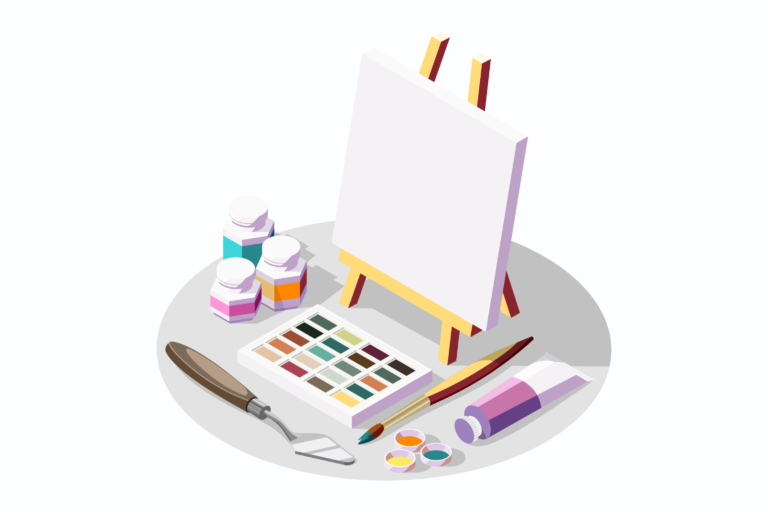Colors have the power to evoke certain emotions and play an essential role in how we experience art. From Vincent Van Gogh’s bold brushstrokes to Claude Monet’s pastel tones, colors have been used by artists throughout history to convey emotion and tell stories. This article will explore how some of the world’s most talented artists use color to express their ideas, as well as uncover their theories about the creative power of color.

Colors in Art
Colors have played a pivotal role in art for centuries. They’ve left a lasting mark on paintings and photographs throughout history. Additionally, we all admire the beauty of a colorful sunset, but what makes colors truly remarkable? Artists worldwide are exploring color’s ability to evoke emotions, tell stories, and capture fleeting moments.
Artists use vibrant hues and subtle tones, each with a unique approach. Whether through prints, photography, or paintings, every artist adds a fresh perspective to their creations. Explore what these experts have uncovered about the creative power of colors.
Color Theory Overview
Color theory has long intrigued artists, designers, and creatives. Color evokes feelings, sends messages, and establishes moods. Since the Impressionist painters, color has been integral to the creative process. Understanding color’s interactions and emotional effects is key to creating resonating artwork.
We’ll also hear from modern-day artists who push boundaries with color. Furthermore, understanding color theory gives insight into its impact on both artists and viewers.
Artists Discuss Their Color Choices
Artists recognize color’s profound impact on their creative process. This article delves into how leading visual artists leverage color and its psychological effects. Gain insights into the minds behind stunning creations and the pivotal role color plays in their artistry.
Colors evoke emotions transcending aesthetics. Moreover, perspectives from painters, sculptors, textile designers, and creatives reveal why certain hues convey meaning within artwork. They’ll also share tips for enhancing compositions through shades and tints.
Discover colorful journeys of renowned artists like Van Gogh, Monet, and Georgia O’Keeffe, who left an indelible mark on the art world with distinctive color palettes. Additionally, color isn’t just inspiration; it’s a powerful tool for connections.
Color Psychology and Emotional Effects
Color Psychology and Emotional Effects is a fascinating subject that has been explored by many scholars and artists. Colors are known to evoke powerful emotions and influence our behavior, but why?
Famous painters worldwide reveal their theories, demonstrating color’s remarkable impact on emotions. Furthermore, insights into blue for Matisse and Monet, red in Rothko’s struggles, and yellow’s meaning to Van Gogh uncover complex nuances of color psychology.
While there is no universal agreement on the meaning of color, the experts do agree on some common themes. Moreover, some colors have positive meanings and make us feel good, while others are associated with negative emotions. Some colors have a stronger impact than others. But the experts agree on one thing: Color is powerful and can affect our mood in an instant.
How Colors Impact Creativity
The color of our environment has a remarkable impact on creativity. Whether it’s the walls of a museum, a building’s facade, or the colors within artwork, they profoundly influence creative expression. A recent gathering of artists delved into this concept, sharing how different colors and combinations ignited their unique artistic visions.
They recounted stories of inspiration drawn from primary colors to pastel shades. Each artist unveiled personal theories on leveraging color to boost imagination and spark fresh ideas. These insights underscore the undeniable connection between color choice and successful artistic endeavors.
Artists' Perspectives
Artists draw inspiration from many sources, including color. A new study explores how color influences an artist’s perspective and creative process. Additionally, interviews with painters and illustrators reveal personal connections between colors and conveying emotions or stories.
The researchers asked each artist about their theories on the power of color in art. From those conversations emerged interesting insights into how different hues can express joy, sadness, anger, love, or any other emotion that resonates with the artist. Furthermore, many shared stories of past experiences that influenced their use of certain colors in particular works of art.
Abstract vs. Figurative Art
Abstract art conveys emotions without physical forms. Often referred to as non-representational or non-figurative art, it stands apart from figurative art, which captures real-life elements in its work. But how do two different artists utilize color to express their creative interpretations and narrate stories through both abstract and figurative artwork?
Ella Lopez’s abstract pieces blend vibrant colors, evoking joy and happiness. Texture and line create movement in her pieces, each with a unique narrative guided by colors. In contrast, Raul Figueroa’s figurative artwork brings characters to life with vibrant colors, infusing images with realism. Both employ color for self-expression, figuratively or abstractly.
Conclusion
It has been a journey of exploration into the hidden depths and vibrant power of colors. It has become clear through the stories and experiences shared by renowned artists that color can have a powerful impact on one’s creative process, whether it be to evoke certain emotions or stimulate the imagination. With their insights, we now have the opportunity to dig deeper into this fascinating topic and discover more about how color shapes our creative endeavors.
In conclusion, we are reminded that creative processes are deeply personal. However, when investigating how color can influence one’s creativity, there is no limit to what we can learn by exploring its potential.
